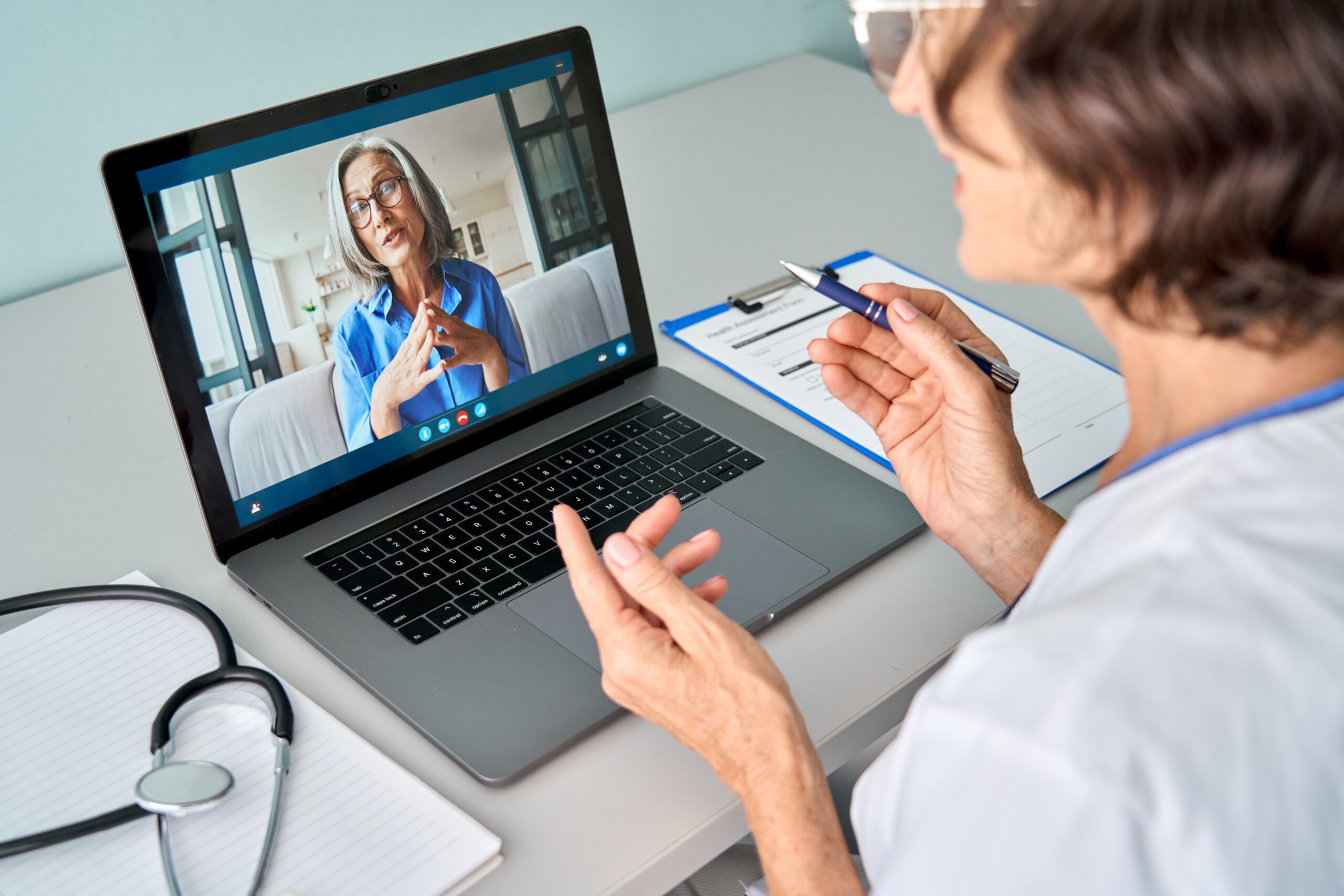Table of contents

Noah Martin
A third-year doctorate student in the occupational therapy (OTD) program at Washington University in St. Louis School of Medicine
There are many benefits for senior living residents that a telehealth service delivery model provides, including improved access to service providers, reduction in delays in receiving care, coordination of care between practitioners, and increased access to care. Although access to care for residents has improved with telehealth, there are various barriers to telehealth that may limit a resident from receiving care that is accessible and resident-centered.
This guide identifies telehealth-specific barriers and proposes strategies to proactively limit those barriers that a resident and clinical team might encounter during a telehealth visit.
Difficulty with hearing and vision
Gradual loss in hearing and vision is a normal process in aging, but it can make communication through technology increasingly difficult and increase frustration for older adults when connecting with clinical providers. According to the National Institute on Aging, about one-third of older adults have hearing loss, and the chance of developing hearing loss increases with age. Therefore, care navigators and clinical teams should utilize a Bluetooth speaker and adjustable iPad stand to proactively prepare to adjust the volume and distance between the iPad and resident during telehealth visits to practice patient-centered care.
Difficulty communicating thoughts
People with aphasia or language disorders may experience difficulty with listening comprehension, verbal expression, reading, and writing during communication interactions, such as a telehealth visit. Clinical teams and care navigators should implement compensatory strategies, such as using live captioning, asking yes and no questions as appropriate, and encouraging the resident to express themselves as they feel comfortable.
Other sensory impairments
Older adults are more dependent on vision to maintain their postural stability as they age, which could lead to increased muscular fatigue during telehealth visits in which they engage in supported sitting for extended periods of time. Residents should be instructed to conduct telehealth visits in a comfortable chair or bed based on their physical, cognitive, and sensory needs.
Cognitive deficits
Some mild changes in cognition are part of the normal aging process; however a person with dementia may experience additional difficulty navigating telehealth.
According to the Journal of the American Medical Directors Association, individuals with dementia may experience more difficulty problem solving, navigating technology, and adapting to their sensory needs. A person with dementia may require additional support from a care navigator to navigate potential barriers during a telehealth visit.
Technological literacy
Older adults may have limited technological literacy and comfort with telehealth video calls, which can be further exasperated by sensory and cognitive impairments. Clinical teams and care navigators can help residents feel more comfortable with telehealth video calls by conducting a practice call prior to their appointment to familiarize the residents with the technology.
Language proficiency
Residents who speak English as a second language may have more difficulty expressing their concerns and navigating technological difficulties. Care navigators and interpreters should be present to offer support during telehealth visits.
Privacy concerns
According to the Canadian Medical Association Journal, virtual telehealth visits are susceptible to breaches of privacy due to unregulated home environments, concerns with sound transmission, and digital video conferencing. Clinical teams and care navigators should encourage residents to conduct telehealth visits in a private area, such as their apartment.
Effective Strategies to Overcome Barriers to Telehealth Accessibility
Many of the issues related to telehealth barriers to accessible care are complex and require public health intervention and systemic solutions. However, there are some simple strategies that can be utilized to proactively reduce telehealth barriers that can occur before, during, or after a telehealth encounter.
Communication adaptations
Speak distinctly and clearly. Slow down the rate of speech used when talking with older adults with hearing loss to improve articulation and clarity during communication. Avoid increasing the volume of speech by talking loudly or shouting, as this can raise the sound pitch and distort language shapes and words on your lips.
Monitor for visual cues. Be aware of visual and body language cues that the resident hears and understands the telehealth conversation. For example, nodding along during communication, looking to the care navigator to respond or repeat what the clinical team member stated, or responding inaccurately to the prompt. If a resident does not appear to understand, repeat or rephrase the prompt and continue to encourage a comfortable environment to ensure communication.
Use teach-back techniques. A teach-back technique involves the provider explaining important information to the resident, and then asking the resident to repeat it back to them in their own words to ensure the resident understands the information that the clinical team is providing by the end of their telehealth visit. This technique can help to reiterate the main points discussed and any required actions to take prior to the resident’s next visit.
Physical adaptations
Bluetooth speakers. Bluetooth speakers should be used with all residents, but especially for residents that are hard of hearing to increase sound volume during their telehealth visits. Bluetooth speakers can be placed in locations that are closer to a resident, such as directly next to them on a table or chair to decrease the distance between the resident and the iPad and increase the volume of the clinical team member’s voice during their visit.
Headphones. Earbuds or headphones can be used to increase privacy for either a resident or a clinical team member if appropriate.
Gooseneck iPad stand. The iPad stand can be attached to any table or table leg and extended to decrease the physical distance between the iPad and the resident to accommodate for visual deficits.
Technological adaptations
Large text. Enlarging the text on an iPad can maximize the amount of visual input a resident will gain during telehealth visits, specifically when they may have difficulty seeing smaller print or seeing the clinical team member conducting the telehealth visit.
Increase contrast for iPad display. Increasing the contrast will increase the difference between the lightest and darkest parts of an image, which can help to make images appear sharper and more vivid. It can also improve readability for text on a screen for people with visual impairment and low vision.
Live captions. Live captioning can be enabled on the Microsoft teams app to provide an alternative option to participate in a telehealth visit when residents are hard of hearing.
Process adaptations
In-person support. The presence of in-person support from a care navigator during all telehealth visits.
Reach out in advance. Communicate with residents ahead of telehealth visits to remind them of their appointment and advise them that a care navigator will be present to assist with the visit.
Hire an interpreter. An interpreter could allow for residents that speak English as a second language to communicate with the clinical provider more effectively. Interpreter services can be available through Microsoft Teams by adding the language interpretation option to a created meeting and inviting your organization’s interpreters to join.
Conclusion
By implementing these strategies, healthcare providers can better accommodate the unique needs of senior residents and overcome barriers to telehealth. Ensuring that every resident receives the quality care they deserve, regardless of the medium, requires a comprehensive approach that considers the physical, cognitive, and emotional aspects of their well-being. This holistic approach not only enhances the effectiveness of telehealth services but also fosters a more inclusive and supportive healthcare environment for all residents.
Telehealth is a major component of EmpowerMe 360 by EmpowerMe Wellness — a holistic approach to healthcare for residents of senior living communities. Our on-site teams can facilitate virtual visits with physicians and nurse practitioners, giving seniors 24/7 access to acute, urgent, and even specialty care. It’s all part of our 360-degree coverage of all our residents’ wellness needs!
About the Author
Noah Martin is a third-year doctorate student in the occupational therapy (OTD) program at Washington University in St. Louis School of Medicine. Originally from Cedar Rapids, IA, Noah completed his undergraduate studies at the University of Iowa, earning a BA in Health and Human Physiology with a Certificate in Disability Studies. He is currently finalizing his degree with a culminating capstone experience at EmpowerMe Wellness. Over the summer, Noah worked on a capstone project focusing on the importance of telehealth as a service delivery model, particularly in providing comprehensive and patient-centered care for older adults. Through his experience with EmpowerMe Wellness, he gained valuable insights into healthcare leadership, learned from medical professionals and senior living residents, and gathered information from the EmpowerMe 360 program. Following the completion of his capstone, Noah plans to study for the NBCOT exam to become a board-certified occupational therapist, with a goal of serving the geriatric population.



